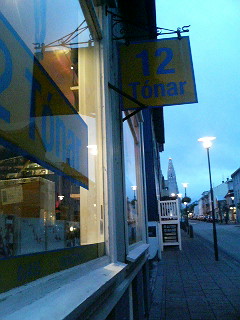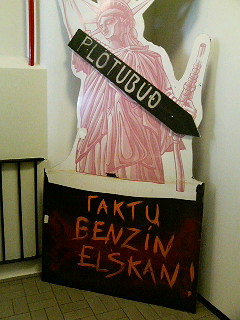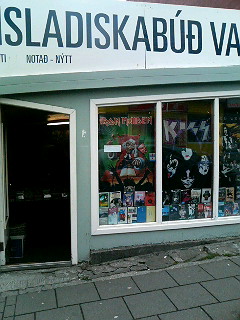Nonetheless: one thing you have got to keep in mind is that while Newtown is by far the most Bohemian district of Sydney, it is different from Bohemian communities elsewhere in the world. This is Australia after all, and the Australian personality still shines through -- perhaps even more blindingly than out in the Burbs. Along with Darwin, this is one of the last surviving outposts of the classic Aussie larrikin. Instead of openly rebelling against the basic Australian personality, as you might expect, Newtown folks caricature it, camp it up, and basically push that personality to its logical extreme, in the process transcending it. Take the issue of fashion, for example. Australians have always been decidedly daggy dressers, and many honestly don't give a damn how they look ("it is fashionable not to be fashionable," my mate Garnet Mae once complained). In rebelling against this, you might expect the subcultures of the inner-city to go the other way, and embrace European style haute couture, to prove they have more taste than the slobs out in the suburbs. That is indeed what happens, in some quarters (like Surry Hills). The Bohemians of Newtown, however, prefer the natural look -- sans shirt, bare feet, the potency of body odor. Whatever gets you closer to Mother Earth, that's what they go for. Now in an already laid-back society, one might think this is a strange way for a supposedly contrarian subculture to express its sartorial instincts. Like the anime addicts of Akihabara, like the Cosplay chicks of Harajuku, the Newtownians knows that the really contrarian way to rebel is not to oppose diametrically, but to mimic to the point of excess. Not just to ridicule, but to take ownership of the dominant culture, and live it the way it was supposed to be lived, before it got corrupted by The Man. Like the urban tribes of Tokyo, the Bohemians of Newtown know this is how you win the culture wars, this is how the real jihad should be waged. Once you stop attacking the dominant culture and start appropriating it, with a gleam in your eye which suggests you were never against it to begin with, the rules of the game are abruptly changed. You cease being silly freaks on the margins, bereft of influence and power, and recast yourselves as true disciples, the Guardians of the Way. Your way is not the alternative but in fact the Only Way: the Tokyo way, the Japanese way, the Australian way, whatever the paradigm that you are seeking to overthrow. In short, you subvert the system from within, by becoming the system, wearing it like an old coat. Or a pair of faded board shorts, if you happen to live in Newtown.
 |
| "I have a dream": Martin Luther King tribute in Newtown (Australia, 2007) |
That was 1993, 14 years ago. I don't know if the Kastle is still around, or what Stu Ridley is doing these days. I'm walking on King Street, the spine of Newtown, whiling away some hours while Garnet is at work, hustling customers on the phone. It's a grey day; the sun is struggling to break through the clouds. At 305 King Street, I stop to admire an iconic piece of street art: the Martin Luther King mural painted by the anarchistic Unmitigated Audacity Productions in the early 1990s. Not quite Banksy, but it is as good as it gets in Sydney. I don't know if the Gothic typeface is appropriate, but it would probably make for a good tattoo. It's about lunch time, and I am feeling peckish. There is certainly no shortage of culinary choices in this vicinity, with Thai eateries, Turkish pide joints, and even an African restaurant all within spitting range. I am actually hankering for Bondi-style Portuguese chicken, which I find at Oporto, on the adjacent Enmore Road, the other side of the railway tracks. I know it's fast food, but I don't care. It's soul food to me, and you can't find anything like it in Japan. I eat a burger and chips, as the wind blows garbage around in a nearby parking lot, and diners watch sport on an in-restaurant TV. I would love to sit and chill, but I have things to do. Hunger satiated, I return to King Street, to take a walk on the wild side.
 |
| One of Sydney's entertainment icons, the Sandringham Hotel, at 387 King Street (Australia, 2007) |
Newtown has long been home to large numbers of visual artists and writers. In the 80s it was the hub of independent music with many a band paying its dues in pubs like the Sandringham.
Now the area has become the cradle for the performing arts, actively nurturing young playrights, actors and dancers. So exactly what is about Newtown that attracts the creatively endowed?
The Enmore Theatre's Greg Khoury says that the suburb's artistic leanings go back a long way. In fact, Newtown has thrived since its inception as an artistic outpost to Sydney in the late 19th Century.
It is too early in the day for a drink, so I walk on, past the pubs. Me being me, I decide to check out the herbal shops. I'm looking for a legal way to get stoned. It's been so long, and I always associate Sydney with smoking a bong. I go inside one business, and locate a pack of dubious goodies called "Tribal Trance", or something similar. The proprietor assures me it will do the trick, but I am not convinced. These synthetic marijuana products are always rubbish, in my experience. Still, I have money in my wallet from my new job in Japan, so I figure it should be worth a try! I buy a bag for AUS$20. And I think to myself: Why is everything in Australia so expensive these days?
 |
| U-Turn Recycled Fashion, at 2 Enmore Road, Newtown (Australia, 2007) |
 |
| Exclusive Vintage Clothing, at 383 King Street, Newtown (Australia, 2007) |
Sydney's hunger for vintage and secondhand clothes has fuelled a 15 per cent profit surge for the Salvation Army's retail stores in the last 12 months.
The workers hit the clearing house floor, sorting the hundreds of thousands of tonnes of clothing that arrive each year.
The best clothes are sent to the Salvation Army's inner city stores - in Darlinghurst, Glebe and Bondi Junction - where prices and turnover are higher.
Meanwhile each morning, between 20 and 30 wholesale buyers wait for up to an hour outside the Salvation Army's Minchinbury and St Peters factories. They buy damaged or stained clothes which are then cleaned up and sold at marked-up prices at the Paddington, Glebe and Bondi markets or in commercial second-hand stores in Surry Hills and Newtown...
RECOMMENDED WEBLOGS & WEBSITES
Painting the Bridge







